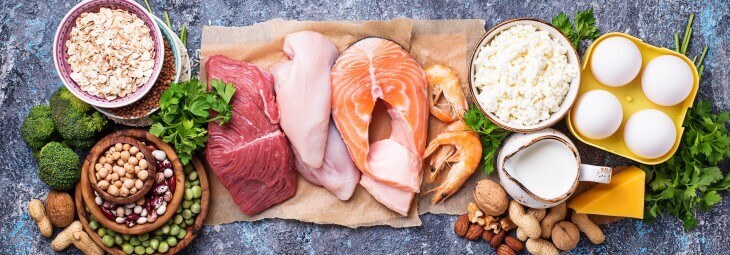
The keto diet is one of the most popular diets for weight loss. There are different forms of following it. You can do a modified version, a cyclical kind, or even a moderate keto. While these are low-carb approaches with different carb intakes, they have one thing in common: they are moderate in protein.
If you are looking for a ketogenic approach with a higher protein intake, you can do the high-protein keto diet plan (HKPD). This can help reduce your cravings and improve your muscle mass.
In this article, you will learn everything related to the HPKD. The benefits, drawbacks, how to start it, food to avoid or avoid, and a one-day sample meal plan to help guide you in this process.
The HPKD is low in carbs, high in protein, and high in fat.
The typical ketogenic diet has a breakdown of 5-10% carbs, 20% protein, and 70-80% fats. On the other hand, the HPKD has a breakdown of 5-10% carbs, 30% protein, and 60-65% fats.
While it follows a very similar carb and fat content from the traditional approach, the protein intake is higher.
Some of the reasons to go this route are to increase or maintain your muscle mass and increase your fullness levels. It is ideal for those athletes who have a large protein requirement.
Now, this doesn’t mean that you can consume unlimited amounts. You still need to control the intake because too much can get you out of ketosis.
This meal plan is not suitable for people who are insulin-dependent, have liver or kidney problems, or are pregnant or breastfeeding.
In addition to the common benefits from a traditional ketogenic diet plan, there are additional advantages when following an HPKD:
One of the advantages is that it helps burn slightly more calories. In the processing of protein, the body burns more calories than the other macros (fats and carbs). Thus, an HPKD can slightly increase your metabolism.
The drawbacks are very similar to those found in a traditional ketogenic diet. Here is a list of the most common drawbacks that you might encounter when doing an HPKD.
Before you make any lifestyle changes, you must consult with your healthcare provider to ensure that you can follow this diet plan. Once your doctor gives you the thumbs up, you can start this process.
Now that we have figured out how many calories and grams of each macronutrient we need. It is time to know which foods we can include and which ones we need to avoid.
First, let’s start with the foods that we are going to avoid:
Next, healthy foods that can be eaten in moderation:
Now, let’s talk about the foods we want to include in larger portions:
It is time to go grocery shopping! To make everything easier, here is a list of the foods you can include to help you next time you go shopping.
Vegetables
Fruits
Protein
Fats
If you don’t know what an HKPD meal plan looks like, here is a one-day sample menu to get you started.
2,457 calories | Total Macros: 34 g net carbs, 203 g protein, and 132 g fats
If you still have questions related to the HPKD, here are the most frequently asked questions.
If you eat more protein than fat, you might not enter ketosis or get kicked out of ketosis. By eating less fat, less ketones are made (because the ketones are made from fat).
Thus, you must take care to stay within your daily limits for protein.
Eating too much could lead to stomach cramps, constipation, intestinal discomfort, dehydration, nausea, irritability, and headaches.
Make sure that you track the amount you eat during the day, as you would your carb intake.
Yes, you can include plant-based options.
However, keep in mind that they are also a source of carbs. For example, quinoa, lentils, chickpeas, and beans are all sources of plant-based protein, but they are relatively high in carbs.
Make sure that you measure the portion size and track the number of carbs accordingly.
Yes, as long as you have a caloric surplus and do resistance exercise. If you don’t eat more calories than your body needs, it is very hard for you to gain muscle mass. While protein intake is important for muscle formation, calories are equally important.
While some people believe that consuming a large intake of this macronutrient can cause kidney problems, you would have to consume a very large quantity for this to happen.
Few side effects are expected at less than 12g per kilogram of body weight per day, but if you’re eating way over this amount, you may be looking for trouble! For someone that weighs 70 kg (154 pounds), too much would be consuming more than 140 g of protein per day. Keep in mind that 100 g of steak, for example, has only 22.8 g of protein.
No, it is an essential macronutrient that your body needs to maintain your muscle mass. It also plays an important role in certain chemical reactions in the body. Thus, you need to consume it, but in a controlled way.